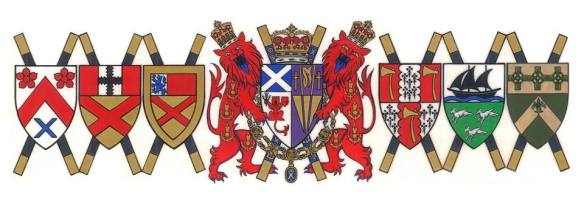Heraldry is the study, design and regulation of armorial bearings, or what is often called “Coats of Arms.” Most scholars of heraldry place its beginnings in the 12th century, when armored knights in battle and in jousting tournaments began to identify themselves through elements painted on their shields. Such designs soon expanded to surcoats worn over the armor, as well as on horses, and, at times, by spouses. Later it became common to attach items – or Crests – to the tops of their helmets, supposedly as a way to deflect weapons’ blows.

(From http://www.box.frodelius.com)
Today the Shield and Crest comprise what has come to be known as an heraldic achievement, or Coat of Arms. The achievement can also include a mantling of “livery” colors, reminiscent of the cloth that hung from the rear of the knight’s helmet. This cloth also forms the torse or wreath that holds the Crest to the particular helmet or crown indicative of the armiger’s social status. The Arms of certain nobles or officers can be granted supporters – creatures holding the shield on either side, often shown standing on a compartment of land or sea. Supporters and compartments are not part of most achievements.

The Armorial Bearings of the Officers of Arms of Scotland’s Lyon Court as of January 2016. At center, achievement of the Lord Lyon King of Arms, impaled with the personal arms of Dr Joseph J Morrow. Heralds, from left, Sir Crispin Agnew of Lochnaw, Rothesay; Mrs. Elizabeth A. Roads, Snawdoun and Lyon Clerk; The Hon. Adam Bruce, Marchmont. Pursuivants from right, Mark D Dennis, Ormond; Mrs Yvonne Holton, Dingwall and Herald Painter; Liam Devlin, Unicorn. (Painted by Yvonne Holton)
As the use of heraldry expanded, the regulation of Arms soon fell to the heralds, who had once serves as royal diplomats, prior to their role in running the tournaments. This move sought to avoid duplication and confusion. Later throughout Europe the regulation of Arms moved to officers appointed by state sovereigns. Today, heraldry remains popular, and several nations, including England, Canada, Scotland, Ireland, Spain and South Africa, continue to regulate armorial bearings. While Scottish Arms have long been available beyond the nobility, given heraldry’s wider historical connections with aristocracy and monarchy, the United States, as a republic, does not grant Arms to private citizens, but many American individuals seek foreign grants of Arms or “assume” Arms for themselves.

Letters Patent from the Canadian Heraldic Authority granting Arms to Vancouver’s The Sir John A. Macdonald Historical Society in 2010.
One of the most common misconceptions about Coats of Arms is that they belong to a family. In actuality, there is no such thing as a family Coat of Arms, even though there are plenty of businesses whose success depends upon you believing that there are. When one purchases Arms from these so-called “bucket shops,” one is actually purchasing someone else’s identification. Since a Coat of Arms is meant to identify an individual, a specific Coat of Arms can belong only to one individual at a time, and are then generally inherited through the male line.
According to Scotland’s Court of the Lord Lyon, “Arms are the visual equivalent of their owner’s name and personal identity. Therefore, wherever it is appropriate to display the owner’s name it is also appropriate to display his Arms.” Arms are often found on signet rings, stationery, flags, dinnerware and other items.

